Lupine Publishers- Environmental and Soil Science Journal
Abstract
The research was conducted on Ghabre Nakhoda and Dara islands in Khore Mosa Creek in Persian Gulf on August in 2003, 2009,
2012, and 2016. Total count method was used to obtain the census of the nests and breeding population of terns and Western Reef
Heron on Islands. Five species of terns and Western Reef Heron had bred on Ghabre Nakhoda and Dara islands in 2003, 2009, 2012,
and 2016. Average breeding pairs of Lesser Crested Tern Thalasseus bengalensis, Swift Tern Thalasseus bergii, Bridled Tern Sterna
anaethetus, White-cheeked Tern Sterna repressa, Caspian Tern Hydroprogne caspia and Western Reef Heron Egretta gularis
were
1368, 63, 217, 71, and 13 pairs on Ghabre Nakhoda and 127, 7, 54, 4, 9,
and 6 pairs on Dara, respectively. Thirty-one species from
ten families belonged to two order of water birds recorded on August in
2003, 2009, 2012, and 2016 on both islands. Total number
of counted water birds was 26303 individuals on Ghabre Nakhoda and 17404
individuals on Dara Island in 2003, 2009, 2012 and
2016. Maximum species richness on Ghabre Nakhoda was in 2016(31
species), but on Dara island was in 2009(18 species).
Introduction
The detailed knowledge of general seabird ecology and of
the numbers and productivity of many populations makes them
particularly appropriate as a choice of bio-monitor or bio-indicator
[1,2]. The colonial nature of breeding seabirds has several benefits.
It allows numbers to be tracked for less effort than if the breeding
populations were dispersed, and it allows large quantities of data to
be collected from a particular site in a relatively short period of time.
However, to be useful, a bio-monitor must respond in a sensitive
way to changes in the variable for which it is a proxy measure [1,2].
It is widely accepted that the number of water birds using a site is a
good indicator or that site’s biological importance, and they are also
important indicator of the ecological condition of their habitats [3].
Terns are colonial breeding in Persian Gulf islands [ 4-7], and are
bio-indicators to monitor the status of the environment of Islands
[8]. There are 34 islands on northern part of Persian Gulf belong
to Iran, six of them located in Khore Mosa in Khuzestan province
[7]. Ghabre Nakhoda located in Middle of Khore Mosa and Dara at
mouth of Khore Mosa (Figure 1).
The creeks and islands in the Khore Mosa are suitable sites for
fishing and harvesting of shrimps and other aquatic species [7].
Terns, Herons, Gulls and Waders form important animal group
heavily dependent on the islands for their continued existence
[9]. There are many species of these seabirds in the Persian Gulf,
[10,11] but the Ghabre Nakhoda and Dara Islands is important
breeding site for terns, three in particular nest in vast number
on the islands, these are the Lesser Crested Tern Thalasseus
bengalensis,, Swift Tern Thalasseus bergii and Birdled Tern Sterna
anaethetus. These three species of terns are dominant breeding
in most islands of Persian Gulf [5,6] Herons notably Western Reef
Heron Egretta gularis Little Egret Egretta garzetta and some wader
species especially Crab Plover Dromas ardeola breed on this
island
[5,7,9,11,12]. Although the islands still support substantial water bird
foraging and nesting populations, recent surveys suggest that
population size has been reduced from historic levels. On the other
hand, one of the aims of monitoring is to provide information for
ecological assessment, which can provide early warning of changes
that could negatively affect species or ecosystems [8]. For these
reasons and protecting the sensitive habitats of water birds in
Persian Gulf, also to awareness of breeding population changes
for protecting the sensitive habitats, present study was carried out
to count and compare the present population of colonial breeding
tern’s species on Ghabre Nakhoda and Dara islands in Khore Mosa
Creek in Persian Gulf in the breeding season.
Methods and Materials
Study Area
Khore Mosa Creek (30o11’01”N49o01’56”E) is consisted of
several estuaries, creeks, and a main canal and is an important
place for fisheries and aquaculture activities. All creeks around it
are most important intertidal habitats of the Persian Gulf shoreline.
There are a lot of small islands in Khore Mosa, but two of them
(Ghabre Nakhoda and Dara) are important habitats for water birds
(Figures 1 & 2). These islands are flat, sandy and Shelly, 70-90%
of area of the Ghabre Nakhoda Island covered by vegetation in Feb
and March, but More than two third of Dara island surface covered
by water by a small branch of creek. All around of the islands are
sandy beach (Figures 1 & 2). Area of the Ghabre Nakhoda Island
is 3 hectares in high tide and more than 800 hectares in ebbs.
There is a Grave in the middle of island, named Ghabre Nakhoda
(Ghabr mean is Grave and Nakhoda meaning is Captain). Area of
the Dara Island is 160 ha. Main plant species of both islands are
Atriplex leucoclada, Stipa capensis, Suaeda fruticosa, Halostachys
belangeriana, Calanderula persica, Malva sp, and Cistanche tubolusa.
Cistanche tubolosa is vulnerable specie, Calendula persica is an
endemic species [5,6,8].
Data Collection
The nests of terns and Western Reef Heron were counted directly
on Ghabre Nakhoda and Dara Islands on August 2003,2009,2012
and 2016. The nests of Lesser Crested, White Cheeked, Caspian, and
Swift terns (on sandy place of islands without any vegetation) and
Western Reef Heron (on short bushes) were counted easily, because
they were visible, (Figure 2). The nests of Bridled Tern were under
the short bushes and were counted by looking under the bushes.
Observation was done on August 15th, every year, which all breeding
species had made nests and finished egg-laying. All birds observed
and counted on mudflat of around of both islands, Ghabre Nakhda in
morning (08:00Am to 12:00PM) and Dara at 14:00PM to 18:00PM.
The existing birds were counted directly by total count methods at
low tide. For accurate birds counting and determination, binocular
40×10 and telescope 15×60 was used. The birds were identified
by studying their characteristic features in accordance with the
identification keys evolved by Porter et al. [13], Colin [14], Baharat
et al. [15], Sonobe & Usui [16] and Grimmett et al. [17].
Statistical Analyses
Species diversity, similarity percentage, evenness and species
richness between water birds’ communities, in 2003, 2009,2012,
and2016 were measured by Simpson’s, Shannon-Wiener,
Menhinnink, Margalef and Brilouin indexes as fallow [18].
Simpson’s index diversity:

Where,
1-D = Simpson’s index of diversity, Ni = Number of individual
of species i in the sample, N = Total number of individuals in the
sample = Σni, S = Number of species in the sample
Shannon-Wiener index as:
H ' = Σ ( pi)(log2 pi)
Where,
H’ = Index of species diversity, pi=proportion of total sample
belonging to ith species
Marghalef index:
=S-1/ln N
S= Number of species and N= total number of all individuals
Menhinnink index:

S= Number of species and N=total number of all individuals in
sample.
Brilouin Index:

Where,
H=Brilouin index, N= Total number of individuals in entire
collection, n1=Number of individuals belonging to species 1, n2=
Number of individuals belonging to species 2, and
Evenness index:M

Where,
D = Observed index of species diversity, Dmin = minimum
possible index of diversity given S and N., Dmax = Maximum
possible index of diversity given S species and N individuals
Percentage similarity:

Where,
P = Percentage similarity between sample 1 and 2, P1i =
Percentage of species i in community Sample 1, P2i = Percentage of
species i in community sample 2.
Density analysis: The individual and total water bird densities
for different years on Ghabre Nakhoda and Dara islands were
calculated as numbers per hectare (Krebs 2001).
Result and Discussion
Species and Populations of Birds on Ghabre Nakhoda Island
Five species of terns and Western Reef Heron had bred on
Ghabre Nakhoda Island in 2003, 2009, 2012, and 2016 (Table1).
Average nests number of Lesser Crested Tern Thalasseus bengalensis
were, 1200 nests (69.04%), (one egg on each nest, 1200 pairs),
Swift Tern Thalasseus bergii 60 nests (3.4%) (one egg in each
nest, 60 pairs) mixed with Lesser Crested Tern Sterna bengalensis,
Bridled Tern Sterna anethetus 154 nests((8.86%) under the short
bushes with154 pairs, small colony of White-cheeked Tern Sterne
repressa, 4 nests(0.23%), and Caspian Tern Hydroprogne caspia
49 nests(2.82%) with 49 pairs had been bred in four years. Lesser
Crested Tern and Swift Tern had bred on sandy ground on the
islands. The Western Reef Heron breed on short bushes of Atriplex
leucoclada, on the islands. The breeding population of terns and
Western Reef Heron declined from3134 pairs in 2003 to 868 pairs
in 2016. Reduction was 27.70% (Figure 3).
Figure 3: Number of nests of terns and Western Reef Heron on Ghabre Nakhoda Island on August 2003, 2009, 2012 and 2016.
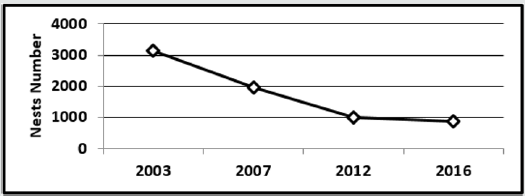

Table 1: Comparison of number of nests of terns and Western Reef Heron on Ghabre Nakhoda Island on August 2003, 2009, 2012
and 2016.


The mudflats around Ghabre Nakhoda hold many hundreds
of shorebirds and water birds in winter, also in summer, including
large number of Numenius arquata, Numenius phaepus, Caldris
minuta, Tring stegnatlis and Laridae species (Table 2). Thirty-one
species of water birds belonged to eight families were identified
on this island from 2003 to 2016. (29 species in 2003, 30species
in 2009, 30 species in 2012 and 31 species in 2016) (Table 2).
Counting was done at low tide and the area of the island was about
800 ha. Out of 31 species, the Crab Plover, Lesser crested Tern
consisted more than 74.27 % of bird’s community in four years
(Table 2). Five species were more than one percent and 24 species
were less than 1%. Maximum birds were counted in 15 August
2016(8353 individuals 31.75%) and minimum birds were counted
on15 August in 2003(5657 individuals 21.50 %). Number of
counted birds increased from 2003-2016, 5657<5941<6350<8353
(Figure 4), but the number of species was approximately stable
(29-31 species). Comparing these numbers, it can be shown that
the number of water birds increased (10.25%) (Figure 4), but the
breeding pairs declined from 2003-2016(Figure 3).
Figure 4: Total number of birds recorded in Ghabre Nakhoda Island on August in2003, 2009, 2012, and 2016.
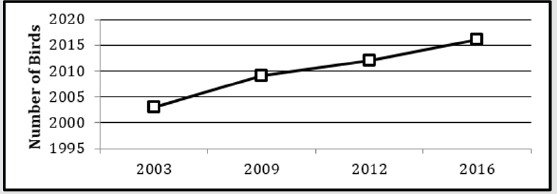

Similarity of Water Birds Community on Ghabre Nakhoda
Table 3 shows the similarity between birds within 4 years on
Ghabre Nakhoda Island. Similarity of breeding species was more
than 70% within four years. The lowest similarity was between
2012 and 2016(70.12). The similarity between birds observed
within four years were more than 70%. Highest similarity was
86.15 % (between 2009 and 2012) and lowest similarity was
58.01% between 2003 and 2016.
Species Diversity
Ecological Methodology software by Krebs 2001 was used to
determine and compare the diversity of the water birds on Ghabre
Nakhoda Island. The total bird species richness (No. of species
present Table 2) was maximum in 2016(31 species) and minimum
in 2003(29 species). Shannon Wiener index (H´) (Table 3) for total
birds on Ghabre Nakhoda Island was on higher side with maximum
during August 2016(1.82) and minimum in 2009(1.401) The
evenness for total birds was maximum in August 2016 (0.199) and
minimum in August 2009(0.1353). The value of evenness was found
highest (0.199) in 2016 and lowest (0.1353) in 2009. The Simpson’s
index of dominance was highest in 2003 (C=0.3451) and lowest in
2012 (C=0.2742). Marglef’s richness Index varied between 3.24
(2003, 3.337 in, 2009, 3.312 2012 and 3.322 in 2016), (Table 4).
Species and Populations of Birds on the Dara Island
Dara Island is Greater than Ghabre Nakhoda, with a chain of
high vegetated dunce along its western and eastern margins and
around the southern end. The central part of island covering by
water during high tide is without plant (Figure 2). Western part
of island covered by vegetation is a suitable place for breeding of
Bridled Tern. Nests of the breeding birds were counted at high tide
and the area of island was 160 ha (Figure 1). Five species in 2003
six species in 2009, four species in 2012 and four species in 2016
had been bred on this island (Table 5). Breeding bird’s population
increased from 164 pairs in 2003 to 347 pairs in 2016 (Figure
5). Breeding pairs of birds increased about two times. The Lesser
Crested Tern was the dominate breeder species and breeding
population of this species increased from 110 pairs in 2003 to 506
pairs in 2016. 142 pairs of Bridled Tern had bred in 2016 but had
not bred in 2003. White-cheeked Tern had not bred in 2012 and
2016, but had bred in 2003 and 2009 (Table 5). In general, the
total breeding population increased from 2003 to 2016 (Figure
5). Eighteen species of water birds were identified on the island
in 2003, 2009, 2012, and 2016, (Table 6). Population of these 18
species increased from 4007 in 2003 to 5083 individuals in 2016
(Figure 5). Counting was done at low tide and the area of the island
was about 500 ha.
Figure 5: Total number of nests of terns and Western Reef Heron on Dara Island on August in 2003, 2009.2012 and 2016.
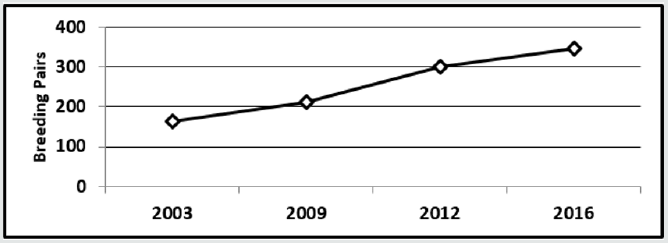

Species Diversity
Diversity is a major aspect of species structure in avian
community. Ecological Methodology software by Krebs 2001 was
used to determine and compare the diversity of the water birds
on Dara Island. Table 7 shows the diversity of water birds on Dara
Island in 2003-2016.The Shannon’s index of diversity was found
highest (H =1.66) in 2016 and lowest (H =1.078) in 2003. The value
of evenness was found highest (0.3186) in 2012 and lowest (0.196)
in 2003. The Simpson’s index of dominance was highest in 2003
(C=0.5519) and lowest in 2012 (C=0.3196). Krebs (2001) stated
that this index gives relatively less importance to rare species and
more to common species [18]. The value of Simpson’s Index in the
2012 was 0.6804 i.e. closer to ‘1’, thus, having higher dominance
as compared to the value 0.4481 (closer to 0), indicating the
lower dominance in August 2003. Simpson (1949) opined that
dominance varies inversely with diversity which is in consonance
to the present observations) [19]. Marglef’s richness Index varied
between 1.641-2.05 (1.688 in, 2003, 2.05 in 2009, 1.672 in 2012
and 0.1.641 in 2016).
Similarity
The similarity percentage of water bird’s community among
four years on Dara Island has been showed in Table 8, it shows there
is some difference between breeder species (5 species in 2003 and
4 species in 2016) and breeding population of water birds (164
to 347 pairs) in August 2003 and 2016. These two numbers show
that the number of water birds increased (21.17%) in 2016 (Table
6). Despite the differences in the populations of water birds, the
similarity between observed species and population were more
than 70%. Highest similarity was between 2009 and 2016(79.68%)
for breeding birds, the lowest similarity was between 2003 and
2012 (57.55%). Highest similarity was between 2009 and 2016 for
observed birds and lowest similarity was between 2003 and 2016.
Bird Species Dominance
Dominance results when one or several species control the
environment and conditions that influence associated species [20].
A total of 31 species were observed and recorded in and around
islands covering both, waders and wading birds. The results
indicate that overall 5 bird species dominated the area in terms
of relative abundance (Tables 2 & 6). It was revealed that Bridled
Tern Sterna anaethetus was the most dominant (46.23%) fallowed
by Crab Plover Dromas ardeola (33.90%), Slender–billed Gull Larus
genei(4.08%), Black Headed Gull Larus ridibundus (3.01%) on Dara
Island, but on Ghabre Nakhoda, Crab Plover (37.57%) flowed by
Lesser Crested Tern (36.70%) and Bridled Tern were dominant
species (Tables 2 & 6). Two species Bridled Tern (12.48%) and
Lesser Crested Tern (78.71%), were dominating breeders on
Ghabre Nakhoda Island in 2003-2016 (Table 1), but on Dara
Island Lesser Crested Tern (49.60%) and Bridled Tern (21%) were
dominant species (Table 5).
Threat and Conservation
Ghabre Nakhoda and Dara islands located in Khore Mosa,
which is part of Shadegan marsh and this wetland is Ramsar
site and wildlife refuge [5,11,21]. Wildlife refuge of 296000 ha,
encompassing all the main wetland areas and the coastal mudflats
in the south was established in 1972 and has remained since then
[21]. The central and southern portions of Shadegan marsh and the
mudflats of Khore–Al-Omayeh and Khore Mosa (a total of 400000
ha.) were designated as a Ramsar site on 23 June 1975[9,11,21].
The site has been identified as an “Important Bird Area” by Birdlife
International [11]. Egg-collecting, chick and female harvesting
when the females sited on eggs, roosting and staying of fishermen
on island (Figure 6), illegal hunting, Pollution of water bodies by
chemical compounds of oil Tankers, motor boats and factories are
serious treats to the breeding population of birds [21]. Poaching
is practiced particularly in the waters around islands. Oil pollution
has been reported on the beaches around Bandar Imam in the
southeast [5]. The breeding success of the species is sensitive to
food availability, predator presence, and human disturbance and oil
pollutions in Khore Mosa [22].
Conclusion
Khore Mosa is an economically and environmentally strategic
creek in Persian Gulf. There are six sandy offshore islands in Khore
Mosa. Khore Mosa and the southern estuaries of the Shadegan
marshes are among the most important intertidal habitats of
Persian Gulf shoreline. It holds considerable commercial and noncommercial
aquatic species and populations. The creeks and islands
in Khore Mosa are suitable habitats for fishing and harvesting of
shrimps and other aquatic species. The specific conditions of the
Khore Mosa, combined with high nutrient content of this water
body, provide attractive conditions for many fish, shrimps and
birds’ species to use it as, nursery, breeding and feeding habitat
[21]. Terns, waders and gulls form main animal group heavily
dependent in the Persian Gulf islands for their continued existence.
There are many species of these seabirds on the islands and also
on Ghabre Nakhoda and Dara, but six species in particular nest
in vast number on the islands. These are the Western Reef Heron
Egretta gularis, Lesser Crested Tern Thalasseus bengalensis, Whitecheeked
Tern Sterna repressa, Swift Tern Thalasseus bergii, Bridled
Tern Sterna anaethetus and Caspian Tern Hydroprogne caspia. All
six species occur together on Ghabre Nakhoda and Dara Islands, but
each has distinctive nesting habitats, (Figure 1). Ghabre Nakhoda is
ecologically extremely important for breeding and wintering of
many migratory water bird species, as well as a breeding site for
Marine Turtles [11]. Ghabre Nakhoda island is habitat for breeding
birds, including at least 2 pairs of Egretta garzetta in 2003 (this
species did not breed in 2009, 2012, and 2016), five terns’ species,
all together more than3134 pairs in 2003, 1953 pairs in 2009, 997
pairs in 2012 and 868 pairs in 2016, (Table 1) and (Figure 2). Tuck
(1974) reported, Mudflats around of this island are important
staging and feeding habitat for a wide variety of shorebirds, Gulls
and Terns [23] (Table 2), including up to 744 Larus ridibundus, 1368
Larus genei, 169 Larus fuscus, 9882 Dromas ardeola, 75 Naumenius
arquata, 105 Naumenius phaopus. Ghabre Nakhoda, south most
island and furthest offshore, is c.3 ha, almost elliptic, and composed
mainly of sand with some rocky shores in the south and west. It
is fringed with low dunce who encircles a central basin almost
completely covered in dance, low scrub. Main plant community of
the island is Atriplex+Stipa+Suaeda+Halostachys. Lesser Crested
Tern and Swift Tern often make their nests on the bare ground,
where each pair incubates a single egg, soon after hatching, the
young congregate in a flock “crèche” near the water’s edge, where
they are fed by their parents until fledging [24].These two species
unable to colonies areas with too high or too dense vegetation, but
nest sites of the Bridled Tern differ according to vegetation cover,
height of vegetation and other characters of micro-habitat [24,25].
The Bridled Tern prefers place with a certain degree of cover
(Minimum 70%), or even totally covered. Nests of this species are
very simple and make under the scrubs especially under the Suaeda
sp and Atriplex sp (Figure 2). Nests of the White Cheeked Tern
are well spaced out on the beach flat and are often neatly built of
twigs. Two eggs are the usual complement, and the young remains
near the nest during the fledging period. All four Tern species
occur together on Ghabre Nakhoda and Dara islands, but each has
distinctive nesting habitat. Khore Mosa complex (Channels, islands,
beaches, mudflats and sand hills) is the most important habitat for
water birds in Persian Gulf. For this reason, Khore Mosa complex
was suggested for classification as sensitive habitat for breeding
water birds, [7], but egg-collecting, chick and female harvesting,
when the females site on eggs are serious treats to the breeding
population of terns and Crab Plover (Figure 6). Density of bird’s
population increased from7.07 to 10.44 and 8.01 to 10.66 on Ghabre
Nakhoda and Dara respectively from August 2003 to 2016, but
breeding population reduced 27.69% on Ghabre Nakhoda Island
and increased more than two times in Dara from 2003 to 2016.
Comparing these numbers shows, the breeding population move
between to islands. When breeding population of terns on Ghabre
Nakhoda island decrease, it leads to an increase on Dara Island. Little
Egret had bred only on Gabre Nakhoda Island in 2009(2 pairs) and
2 individuals of Ruddy Turn stone Arenaria interpres had observed
in 2009 on Dara Island. Ghabre Nakhoda and Dara islands are
more sensitive habitats during summer, because 6 species of water
birds (Crab Plover, Swift and Lesser Crested Tern, Bridled Tern and
White-cheeked Tern Caspian Tern) breed regularly on these islands.
Breeding population of Crab plover on Dara Island was 11500 pairs
in 2013, but I could not count the nests of this species in 2016, thus
breeding population can’t be compared between 2016 and 2003-
2012. The destruction of historical nesting and feeding grounds has
forced water birds to compete for diminishing resources (Figure 6).
Clearing and degradation of fringing and littoral island vegetation
reduces water bird breeding success as a consequence of the loss
of habitat and increased vulnerability to predation by a range of
species. The following measures should be taken during Breeding
time to protect nests and birds on the two islands. The islands
are required to be stopped appropriately to check the fishermen
boats anchor to prevent further Population loss of breeding birds.
Strengthen enforcement of existing restrictions on the hunting of
breeding birds [26].
a. The breeding success of the species is sensitive to food
availability, predator presence, and human disturbance and
oil pollutions in Khore Mosa, for these reasons Khore Mosa
complex need to be protected during breeding season.
b. It is recommended to initiate study of bird diversity and
population status immediately with periodic monitoring in all
islands for their conservation and management.
Follow on Linked in: https://www.linkedin.com/company/lupinepublishers
Follow on Twitter: https://twitter.com/lupine_online
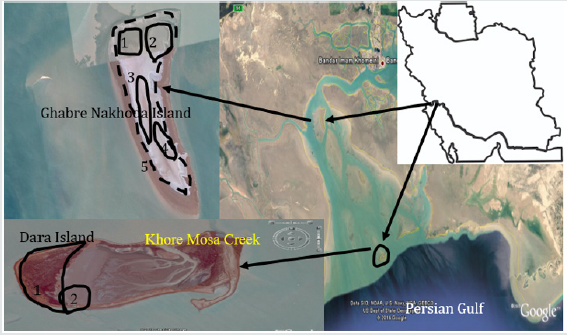
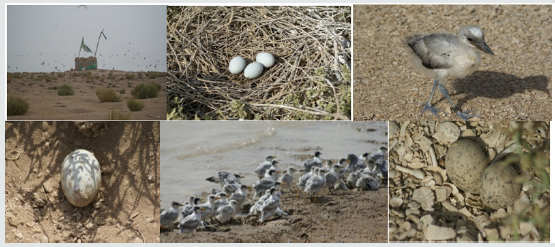
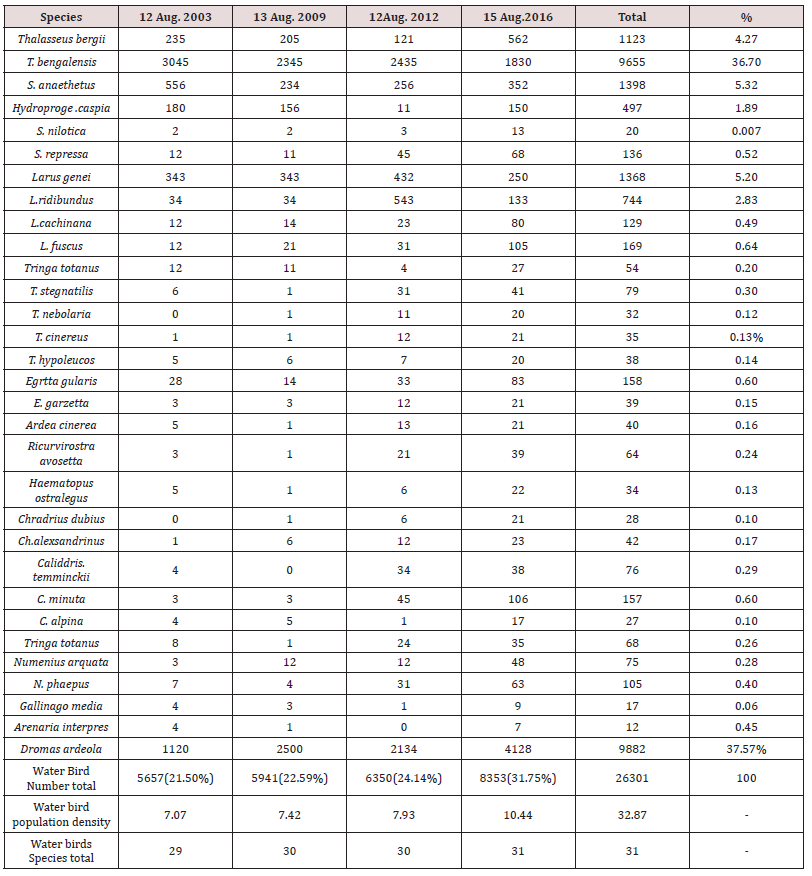




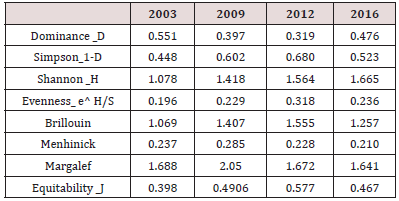
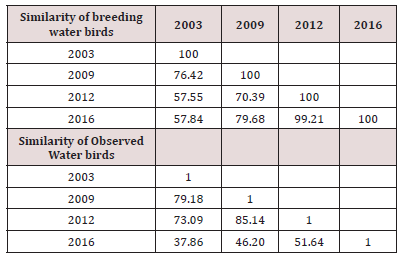
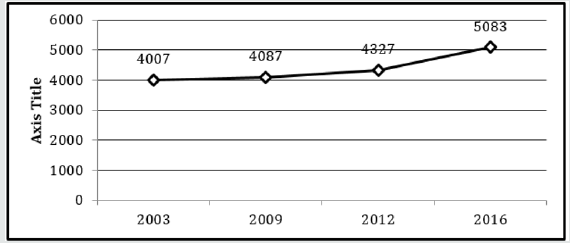
No comments:
Post a Comment
Note: only a member of this blog may post a comment.